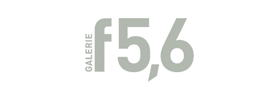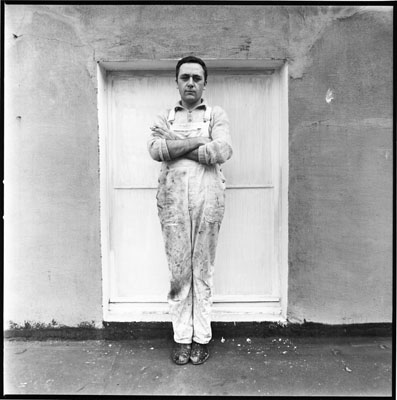
Lothar Wolleh »
Künstlerportraits
Exhibition: 26 Sep – 5 Nov 2008
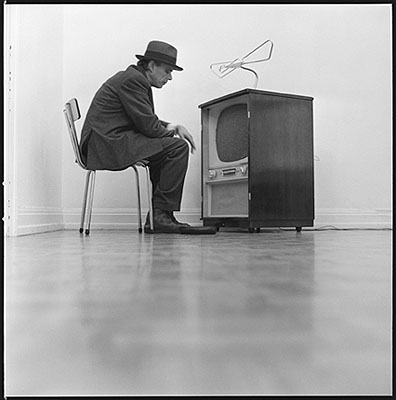
Joseph Beuys Aktion Filz-TV, 1968
28x28 cm /31x31cm, 16 Silber Gelatine Prints auf Barytpapier
Die Galerie f5,6 für Fotografie in München zeigt als erste europäische Galerie Arbeiten einer der genialsten und ungewöhnlichsten deutschen Portraitfotografen der 60iger und 70iger Jahre – Lothar Wolleh (geboren 1930, gestorben 1979) Sein Großprojekt und Lebenswerk sind Künstlerporträts, die er ab den frühen 60er Jahren bis zu seinem plötzlichen Tod 1979 systematisch erarbeitete. Sie entstanden ohne Auftrag, angetrieben allein durch das Ziel der lückenlosen Dokumentation der Kunstszene der 60iger und 70iger Jahre in Deutschland und Europa: es entstanden Aufnahmen von Georg Baselitz, Joseph Beuys, Lucio Fontana, Gotthard Graubner, Heinz Mack, René Magritte, Henry Moore, Man Ray, Roman Opalka, Otto Piene, Gerhard Richter, oder Günther Uecker um nur einige zu nennen. Im Vordergrund jedes Portraits steht eine tiefe emotionale Auseinandersetzung Wollehs mit dem jeweiligen Künstler und dessen Werk. Jedes seiner Portraits, das vor der Aufnahme bis ins Detail in seinem Kopf entstanden ist, ist im quadratischen Hasselblad-Format, mit klarem, stark grafischen Bildaufbau. Zentral ist zweifelsohne auch der integrierte schwarze Rand. Dieser gilt in vor allem in der Fotografie der 60iger Jahre als Beweis für eine nicht manipulierte Aufnahme. Blitzlicht und künstliches Licht lehnte er zudem kategorisch ab. Für Wolleh sollte das Bild einen sachlichen, authentischen Wirklichkeitsausschnitt darstellen, auch wenn er immer der Regisseur seiner Inszenierung blieb. Lothar Wolleh studierte ab 1946 Kunst an der nach dem Vorbild des Bauhauses gegründeten Hochschule für Angewandte Kunst in Berlin Weißensee. Eine Verhaftung durch die sowjetische Besatzungsmacht wegen angeblicher Spionage beendete vorerst früh seine Karriere. Fast sechs Jahre musste er unter erbarmungslosen Bedingungen in einem sowjetischen GULAG ausharren, bevor er 1956 nach Berlin West zurückkehren durfte. Ab 1959 studierte Wolleh an der Folkwang Schule in Essen unter Otto Steinert und zog 1962 nach Düsseldorf, dem damaligen Zentrum für Kunst in Deutschland. Schnell machte sich Lothar Wolleh neben Charles Wilp, Helmut Newton und FC Gundlach einen Namen in der Werbefotografie und avancierte zu einem der bestbezahltesten Fotografen der Bundesrepublik. Parallel konzentrierte er sich zunehmend auf seine autonomen, künstlerischen Projekte und beendete seine Karriere als kommerzieller Fotograf schließlich ganz. Neben den Künstlerportraits fotografierte Wolleh, ebenso ohne Auftrag, die Männer der Wirtschaft. Aufnahmen von Josef Neckermann, Peter von Siemens, oder Rudolf Leiding, der Vater des Golf, oder Mathias Seefelder (BASF), sind das Ergebnis. Andere Projekte in dieser Art sind die erstaunlichen Farbaufnahmen aus dem Vatikan in den frühen 60iger Jahren, oder die Serie des arbeitenden Menschen, angelehnt an August Sanders Werk. Die in diesen Jahren entwickelten tiefen Freundschaften zu Künstlern, vor allem zu Günther Uecker und Joseph Beuys, führten auch zu gemeinsamen Buchprojekten wie dem Unterwasserbuch (1971) mit Beuys oder dem Nagelbuch von 1970 mit Uecker. Andere Kollaborationen finden sich auch in dem für diese Zeit vielleicht erstaunlichsten Werkkomplex wieder: die von den Künstlern selbst überarbeiteten Portraits, die Wolleh zu diesem Zwecke auf Leinwand übertragen hatte. Lucio Fontana zerschlitzte die Leinwand seines eigenen Abbildes, Günther Uecker arbeitete eine Schicht Sand in sein Portrait am Meer, Man Ray applizierte eine Reihe gelber Filmrollen auf sein Portrait in seinem Studio. So entstand eine einzigartige Symbiose zwischen Fotograf und Künstler die in der Kunstgeschichte ihresgleichen sucht. Erst jetzt nach fast 30 Jahren erkennt die Kunstwelt Lothar Wollehs wichtige und vor allem visionäre Arbeit, die die Galerie f5;6 in Zusammenarbeit mit dem Estate Lothar Wolleh nun mit einem Schwerpunkt auf den Künstlerportraits einer breiteren Öffentlichkeit präsentieren wird. Teile von Lothar Wollehs Werk wurden bis jetzt hauptsächlich in Deutschen Institutionen ausgestellt: zb. Kunsthalle Bremen, Museum Kunstpalast, Düsseldorf, Kunstmuseum Ahlen, Ludwig Museum, Koblenz.
We are thrilled to announce that Galley f5,6 in Munich is the first European Gallery to show one of the most genial and extraordinary 1960's German photographers specialising in portraiture: Lothar Wolleh (born 1930, died 1979) For the show Gallery f5,6 will focus on Lothar Wolleh's extensive and systematic lifetime project: Portraits of artists of his immediate environment. Without being commissioned but purely driven by the desire for a complete series of the art scene of the 60's and 70's in Germany and Europe, Wolleh photographed continuously until his sudden death in 1979. He photographed artists like René Magritte, Gerhard Richter, Günther Uecker, Otto Piene, Heinz Mack, Georg Baselitz, Joseph Beuys, Gotthard Graubner, Lucio Fontana, Henry Moore, or Man Ray to name but a few. Wolleh's portraits are the result of a deep intellectual and emotional engagement with the artist and his work. Each portrait was carefully composed before execution, so that even the smallest detail had its meaning. Wolleh always used the square format characteristic of the Hasselblad camera and the black integrated frame on the print. This method was often used in the 60's to denote the ultimate "truth" free of manipulation of an image. Wolleh also categorically rejected the use flash or artificial light. For him the image was supposed to reflect an objective and above all an authentic detail of reality, even if he was directing this. Wolleh studied applied Art from 1946 in Berlin, Weißensee at the Hochschule für Angewandte Kunst, an art school after the model of the earlier Bauhaus. His arrest by the soviet army for alleged espionage, abruptly ended this career. Lothar Wolleh was imprisoned in a GULAG under catastrophic conditions for over 6 years. He was allowed to return to West Berlin in 1956. From 1959 Wolleh studied at the Folkwang Schule in Essen, under one of Germany's most well known photographers, Otto Steinert. Lothar Wolleh moved to Düsseldorf in 1962, the then centre for artistic production. He quickly advanced to one of Germany's most highly paid commercial photographers next to Charles Wilp, FC Gundlach and Helmut Newton. But concurrently Wolleh was more interested in his autonomous projects. Wolleh ended his commercial career in the late 60's and from then concentrated only on his own projects. He also began to function not only as a photographer but began creating many collaborative projects with artists or acted as an art agent and began collecting art. It was in these years that Lothar Wolleh developed deep and long lasting friendships with artists like Günther Uecker or Joseph Beuys, which led to collaborative artistic projects. An example of this is: the joint artists' books like Günther Uecker's Nagelbuch from 1970 or Unterwasserbuch in 1971 with Joseph Beuys. In many senses, this idea of collaboration is reflected most clearly in the extensive collection of over-worked portraits by hand of the different artists that Wolleh had photographed. Wolleh printed his portrait of the artist on canvas often in 100 x 100 cm and asked the artist to work with this. Fontana cut through his portrait, Günther Uecker worked a layer of sand into his portrait at the ocean, Man Ray applied as row of film rolls onto the canvas and Gerhard Richter over-painted his portrait completely. Through this collaborative project an interesting symbiosis between photographer and artist occurred at a very early time, still unique today. Beyond this lifetime project Lothar Wolleh also was interested, similar to August Sander, in documenting people within their careers. He completed an autonomous series on the so-called Men of the German Economy in the 70's from Peter von Siemens to Josef Neckermann, or Rudolf Leiding, father of the VW Golf. Lothar Wolleh also realised book projects on the main Vatican occasions, creating extraordinary colour photographs in the early 60's. On the other hand , he was also interested in the role of the "worker” and continued to work on a series from Germany, Spain and Switzerland. It is only after 30 years that the art world has recognised Lothar Wolleh's visionary and very important work and role. Gallery f5,6, Munich is proud to be able to show his artist portraits in collaboration with The Estate Lothar Wolleh.
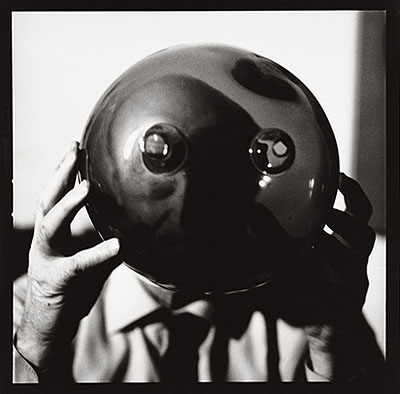
Lucio Fontana mit Kugel
40 x 40 cm, Silbergelatine, Edition 15
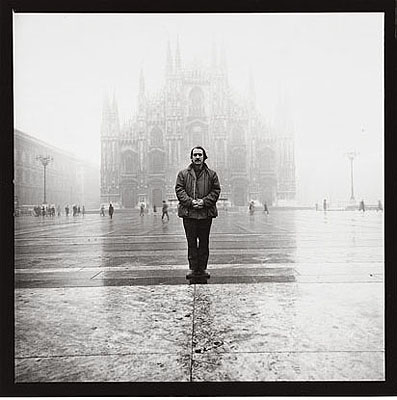
Jean Tinguely
40 x 40 cm, Silbergelatine, Edition 15
